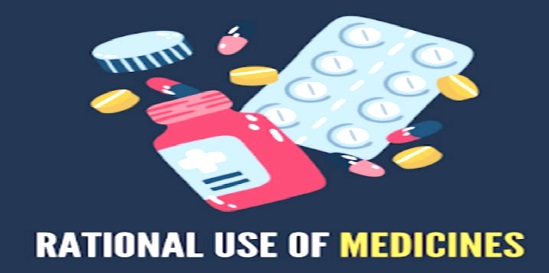
Rational use of medicines: What the public must know
Globally and historically, medicines or medications are used to cure and/or treat disease conditions and other ailments. These medications must not be taken anyhow but rather according to prescribed doses.
Accordingly, it behoves patients and, for that matter, the public to have knowledge of medicinal doses and use those medicines rationally rather than abuse them.
Advertisement
In our public hospitals and other curative healthcare facilities, therefore, healthcare providers must thus follow the Standard Treatment Guidelines (STGs) and other documented protocols to ensure adherence to the rational use of medicines (RUM) indicators.
What is RUM?
According to the World Health Organisation (WHO), RUM requires that “patients receive medications appropriate to their clinical needs, in doses that meet their own individual requirements, for an adequate period of time, and at the lowest cost to them and their community.”
This means that RUM is a logical approach to selecting and administering the most appropriate medications for therapeutic purposes.
Suffice to say that any other arrangement for medication use contrary to RUM constitutes irrational use of medicines (IUM) or medication abuse.
The IUM is a worldwide problem in healthcare delivery. Per WHO estimates, more than half of all medicines are prescribed, dispensed or sold inappropriately and over 50 per cent of patients worldwide fail to take medications correctly.
Inappropriate or irrational use of medications may occur in the form of overdose, underdose or misuse of medications leading to wastage of healthcare resources and resultant widespread of health hazards.
One may cite “polypharmacy” (use of too many medicines per patient), inappropriate use of antimicrobials, overuse of injections, failure to prescribe in tandem with STGs as examples of irrational use of medicines.
Indicators
The overarching goal of adhering to RUM indicators in healthcare delivery is to ensure a therapeutically sound and cost-effective use of medicines by health professionals and consumers or patients.
This goal underscores the fact that adherence to the RUM indicators is a shared responsibility for both healthcare providers and the public.
There are numerous RUM indicators which are broadly classified into (1) prescribing indicators (e.g. average number of medications prescribed per encounter), (2) patient care indicators (e.g. percentage of medications actually dispensed, percentage of medications actually labelled) and (3) health facility indicators (e.g. availability of essential medicines).
In Ghana, similar RUM indicators such as average number of medicines per prescription, percentage of antibiotics use, percentage of injection use, percentage of generic prescriptions, percentage of prescriptions that are in accordance with the essential medicine list, among others.
For example, the Ghana Health Service (GHS) periodically assesses the performance of its curative health facilities based on the RUM indicators.
As such, even as I use this medium to encourage prescribers nationwide to take the RUM indicators seriously in their prescription patterns, I equally want to educate the public that doctors or prescribers do not just prescribe medicines indiscriminately without following guidelines.
Medics follow standard operating procedures in medication prescription and administration. Medications have side effects, hence they must not be used irrationally.
As such, self-medication or self-treatment instead of seeing a qualified prescriber must be eschewed.
Advisedly, drugs and therapeutic committees (DTCs) in our health facilities must also ensure that prescribers adhere to the RUM indicators as part of their prescription patterns.
This way, irrational use of medicines will be discouraged by healthcare providers at least within the hospitals and other curative centres.
Promoting RUM
The WHO puts a dozen of interventions in place for adherence by various national health systems to ultimately promote the rational use of medicines globally.
These interventions include establishment of a multidisciplinary national body to coordinate policies on medicine use, use of clinical guidelines and the development and use of national essential medicine list.
Others are the establishment of drug and therapeutic committees, inclusion of problem-based pharmacotherapy training in undergraduate curricula as well as continuing in-service medical education as a licensure requirement.
The rest of the WHO recommended interventions are supervision, audit and feedback; use of independent information on medicines, public education on medicines, avoidance of perverse financial incentives, use of appropriate and enforced regulation and, finally, sufficient government expenditure to ensure availability of medicines and staff.
To effectively implement the underlisted WHO interventions to ensure and promote RUM in Ghana, the healthcare consuming public, the GHS, Food and Drugs Authority (FDA) and other regulatory bodies such as the Medical and Dental Council, Pharmacy Council, Nursing and Midwifery Council, among others, must work persistently in collaboration with good results, methinks.
Health facilities and public health officials must also educate the public on RUM. In some health facilities, patients accessing health care and assessing quality of care tend to define the quality of care based on the number of medications prescribed and dispensed to them regardless of their health conditions.
They think and argue that the number of medications dispensed to them per hospital visit is a good determinant of the quality of health care they accessed. I dare say that this is an erroneous thought.
Adherence
This article is a reminder to all stakeholders in healthcare delivery in the country to ensure adherence to the RUM indicators and to implement the WHO interventions nationwide.
Perhaps, the FDA must show its teeth in ensuring that healthcare providers and patients use medications rationally. The FDA may also use various fora to educate the public.
Per section 81 of the Public Health Act, 2012 (Act 851), the FDA’s legal purpose of existence (object) is to “provide and enforce standards for sale of food, herbal medicinal products, cosmetics, drugs, medical devices and household chemical substances.”
The identified stakeholders must therefore, synergise, act in unison and in a direction that yields good results and forestalls irrational use of medications.
The writer is a health service administrator. Email Address: [email protected]



